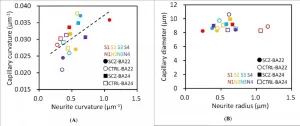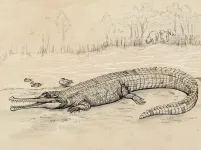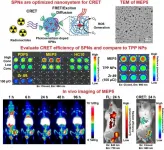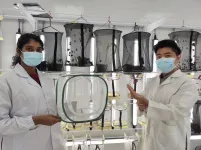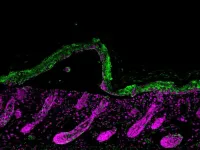(Press-News.org) The 17-year cicadas emerging dramatically by the billions in 15 U.S. states from Georgia to New York and west to Illinois are making quite a racket--a uniquely North American phenomenon--but thousands of other cicada species on the planet also spend most of their lives underground, many of them emerging below the radar of human perception. Because most cicada species don't emerge simultaneously like species in the genus Magicicada--the periodical cicadas--little is known about their natural history. Driven by unusual attention to detail and curiosity, Annette Aiello, staff entomologist at the Smithsonian Tropical Research Institute (STRI) in Panama, joined a very select group of people who have successfully reared cicadas a feat that may reveal their host plants, their reproductive timing and other mysterious facets of their nature--and in this case, may result in the identification of a new species.
According to published records, only three of the many hundreds of cicada species in North, Central, and South America had previously been reared from egg to adult.
Annette Aiello's level of perception for natural history events is a radar system that most of us lack. How many people would cage a houseplant and create a data sheet to record how many cicadas emerge from a pot? That is what Annette did after she saw an empty cicada shell--an exoskeleton--on her mother-in-law's tongue or sword plant (Dracaena trifaciata) in Arraijan, Panama. Several years later, when Brian Stucky was in Panama on a Smithsonian short-term fellowship to study cicada parasitoids, Annette, who usually studies butterflies and moths, told him about her rearing experience and showed him the collection of the 29 cicadas--12 males and 17 females--that had emerged from the pot. For most of them, Aiello was able to collect both the exoskeleton of the nymph and the adult insect.
"The amazing story of this paper is that, just incidentally, Annette had a houseplant sitting on her front porch and she noticed this exoskeleton on it...and then she actually built a huge cage to put the whole plant inside and got all of this data," Brian said. "I was amazed when several years later when we wrote the paper, I needed more information about when she repotted the plant and, of course, she had that information written down, which was just incredible."
The life cycle of most cicadas is simple: females lay eggs in twigs or other plant parts and when the nymphs hatch, they crawl down into the ground and spend the next phase of their lives sipping the water and minerals from plant roots. Sometime later, the mature nymphas crawl out of the soil; the adults emerge; the males sing; the females find them; they mate and the cycle begins again. For most of the cicada species in the world, nothing is known about what plants they lay their eggs on or eat, how long they stay underground, what determines the length of their lives and what influences their decision to emerge from the ground to mate.
Annette repotted her plant about 500 days before the first nymphs emerged. Because juvenile cicadas are very fragile, Annette and Brian think that the eggs must have been laid after the plant was repotted, so the complete life-cycle must be less than 500 days, much shorter than the periodic cicadas in the U.S., which have life-cycles of 13 and 17 years. And unlike the periodical cicadas, which emerge all at once, it took 53 days for the 29 individuals to emerge.
When Brian Stucky, now an artificial intelligence facilitator/consultant in Research Computing at the University of Florida, compared the cicadas Annette reared to others in the collections at STRI, the Natural History Museum in London, and the Florida State Collection of Arthropods, which has a fairly large number of cicada specimens from Central America, he found no other specimens that exactly matched them. He thinks this is probably a new species in the genus Pacarina, but he cannot be sure because there is still not enough information about this group.
To identify this species, a thorough review of all of the records of Pacarina species, sound recordings of their unique songs and the songs of related species, and more information about the natural host plants of the species in this genus across their ranges will be necessary.
"The very limited work that has been done on cicada life-cycles in the tropics has mostly focused on cicadas that are pests of coffee," Brian explains. "When you study these organisms that may take a decade or so to develop, it's not a path to rapid results or publications, so that kind of work just doesn't get done. It's considered low pay-off, at least by the way we currently measure scientific productivity."
But Annette, who is on the staff at STRI, has spent many years rearing butterflies and moths from caterpillars, a more straightforward, but by no means simple task. To rear caterpillars, she has to figure out what leaves they eat, and wait until the caterpillar forms a pupa, from which the adult butterfly emerges.
"When I started rearing lepidopterans, it was just to discover which butterflies and moths come from which caterpillars," Annette said. "Other people have also done this too. Dan Janzen and Winnie Hallwachs reared a lot of caterpillars in Costa Rica."
When she first came to Panama in 1976, Annette spent a lot of time rearing one of the most common butterflies, Anartia fatima. Its host plant is one of the most common weeds, Ruellia blechum (family Acanthaceae) commonly known as Blechum.
The most challenging insect that Annette has ever reared was a scarab beetle. A colleague, Bill Eberhard, brought her a bird's nest that contained two beetle grubs. "I hung it in a breezy place by a mister in a greenhouse so that they would get ventilation and humidity at the same time. One of them made a cocoon, then the other. I kept the cocoons in screen cages in my lab until the two beetles emerged and I could make the connection between the characteristics of the grub and the adult. Finally, I sent the adults to a specialist in the Netherlands who confirmed their identification."
A website called cicadamania.com has this to say about rearing cicadas: "should you decide to raise cicadas consider the following 1) expect 95 % of the cicadas to die, 2) care of the eggs is critical, 3) use host plants preferred by the species, 4) use a species with a short life-cycle, 5) use see-through pots so that you can see the cicadas as they develop."
Entomologists like Annette, who has a permanent research position, and Brian, who supports his passion for cicadas while helping biologists use artificial intelligence for biodiversity research, will continue to learn more about this mysterious group of insects.
"The wonderful thing about natural history is that you get to see things that no one else has ever seen," Aiello said. "I just look for something that seems out of place." Natural history information that researchers like Annette and Brian collect may seem trivial, but these are the experts people call on when they need to identify crop pests, or just an unusually beautiful insect in their garden.
INFORMATION:
The Smithsonian Tropical Research Institute, headquartered in Panama City, Panama, is a unit of the Smithsonian Institution. The institute furthers the understanding of tropical biodiversity and its importance to human welfare, trains students to conduct research in the tropics and promotes conservation by increasing public awareness of the beauty and importance of tropical ecosystems. Promo video.
Environmental bacteria and fungi that end up in the belly of honeybees may be essential to their survival in a changing world as bee populations dwindle due to pesticides, poor nutrition, habitat destruction and declining genetic diversity.
Like many animals, bees have an internal armory. Their guts are home to a multitude of microbes that perform vital functions, from aiding digestion to breaking down toxins and fending off parasites. "A healthy gut microbiota makes bees more resilient to threats such as pathogens and climate change," says KAUST research scientist Ramona Marasco, "highlighting the need to understand how different microbes help their host."
Extensive research into the microbiome ...
Some 42% of patients attending a dedicated diabetes clinic have signs of established chronic kidney disease, the first detailed research of its kind in Ireland has revealed.
The study was carried out by academics at NUI Galway and clinicians at University Hospital Galway Diabetes Centre and involved more than 4,500 patients in the west of Ireland.
The findings suggest that, despite careful medical management, a relatively high proportion of people with diabetes in Ireland are developing chronic kidney disease over time and are at risk of kidney failure and other complications of poor kidney function.
Diabetes ...
Drs. Itokawa, Mizutani and colleagues performed microtomography experiments the BL20XU beamline of the SPring-8 synchrotron radiation facility and found that brain capillary structures show a correlation with their neuron structures.
Brain blood vessels constitute a micrometer-scale vascular network responsible for supply of oxygen and nutrition. In this study, we analyzed cerebral tissues of the anterior cingulate cortex and superior temporal gyrus of schizophrenia cases and age/gender-matched controls by using synchrotron radiation microtomography or micro-CT in order to examine the three-dimensional structure of cerebral vessels.
All post-mortem human cerebral tissues were collected ...
A new species of large prehistoric croc that roamed south-east Queensland's waterways millions of years ago has been documented by University of Queensland researchers.
PhD candidate Jorgo Ristevski, from UQ's School of Biological Sciences, led the team that named the species Gunggamarandu maunala after analysing a partial skull unearthed in the Darling Downs in the nineteenth century.
"This is one of the largest crocs to have ever inhabited Australia," Mr Ristevski said.
"At the moment it's difficult to estimate the exact overall size of Gunggamarandu since all we have is the back of the skull - but it was big.
"We estimate the skull would have been at least 80 centimetres long, and based on comparisons with living crocs, this indicates a total ...
Summer picnics and barbecues are only a few weeks away! As excited as you are to indulge this summer, Escherichia coli bacteria are eager to feast on the all-you-can-eat buffet they are about to experience in your gut.
However, something unexpected will occur as E. coli cells end their journey through your digestive tract. Without warning, they will find themselves swimming in your toilet bowl, clinging to the last bits of nutrients attached to their bodies. How do these tiny organisms adapt to survive sudden starvation? Scientists at Washington University in St. Louis wondered.
Close examination of nutrient-deprived E. coli ...
Reston, VA (Embargoed until 12:30 p.m. EDT, Monday, June 14, 2021) - Researchers have successfully developed a novel cancer treatment approach that utilizes Cerenkov radiation energy to target and destroy cancer cells more effectively. The approach uses light from decaying radiopharmaceuticals, known as Cerenkov luminescence, as an energy source to activate semiconducting polymer nanoparticles that kill cancer cells. This research was presented at the Society of Nuclear Medicine and Molecular Imaging's 2021 Virtual Annual Meeting.
Over the past several decades, many studies have been conducted on photodynamic therapy, ...
Alzheimer's disease is the most common form of dementia and is characterized by neurodegeneration in regions of the brain involved in memory and learning. Amyloid beta and tau are two toxic proteins that build up in disease and cause eventual neuronal death, but little is known about how other cells in the brain react during disease progression.
A new study from the ASU-Banner Neurodegenerative Research Center (NDRC) and MIT/Koch Institute sheds new light on how disease processes manifest in patients with Alzheimer's disease.
Diego Mastroeni of the NDRC teamed up Forest White and Douglas Lauffenburger, colleagues in MIT's Department of Biological Engineering, to explore how protein ...
Osaka, Japan - Researchers from the Graduate School of Engineering and the Center for Quantum Information and Quantum Biology at Osaka University unveiled a new solid state second-harmonic generation (SHG) device that converts infrared radiation into blue light. This work may lead to a practical daily-use deep ultraviolet light source for sterilization and disinfection.
Recently, deep ultraviolet (DUV) light sources have been attracting much attention in sterilization and disinfection. In order to realize a bactericidal effect while ensuring user safety, a wavelength range of 220-230 nm is desirable. ...
Singapore, 14 June 2021 - Many butterfly species bear distinct circular markings known as eyespots on their wings, and the functions of these rings of contrasting colours vary. A long-standing theory is that they serve as anti-predator defences - small eyespots along the wing margin can protect butterflies by directing predators to attack less important parts of the body, such as the hindwings, enabling them to escape.
Most nymphalid family butterflies have half as many eyespots on their forewings compared to their hindwings. In particular, this has been observed in the bush brown butterfly Bicyclus anynana.
A recent research by biologists from the National University of Singapore (NUS) sought to understand the impact of uneven distribution of eyespots. ...
A team of scientists has shown that the healing of skin blisters is driven by hair follicle stem cells, which delay their own development in the process.
The healing process of the tissues in the human body is particularly well-studied in skin, especially as skin serves as a layer of protection from the environment. However, there remain some specific types of skin injuries where the healing process is not well understood.
A team of scientists from Japan and Italy, including Associate Professor Ken Natsuga from the Graduate School of Medicine at Hokkaido University, have used models of skin blisters to explore the effects of injury on developing skin tissue. Their discoveries ...


